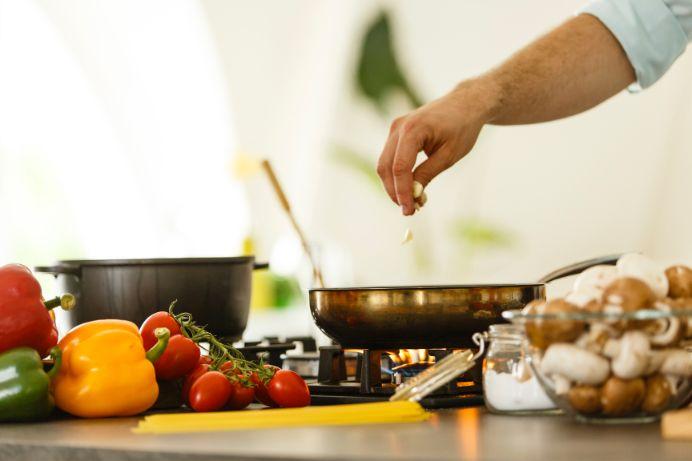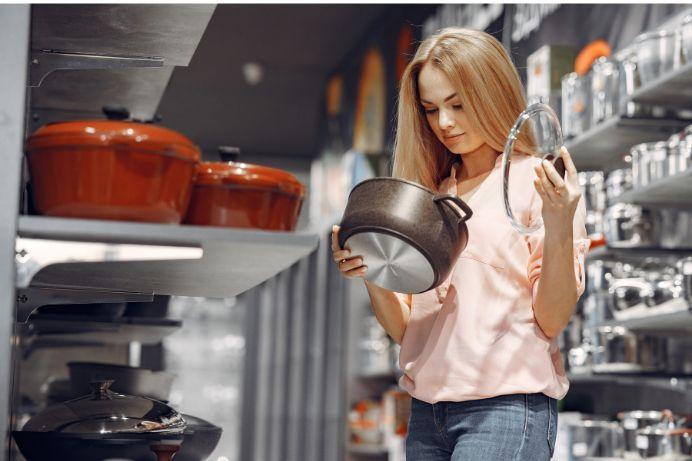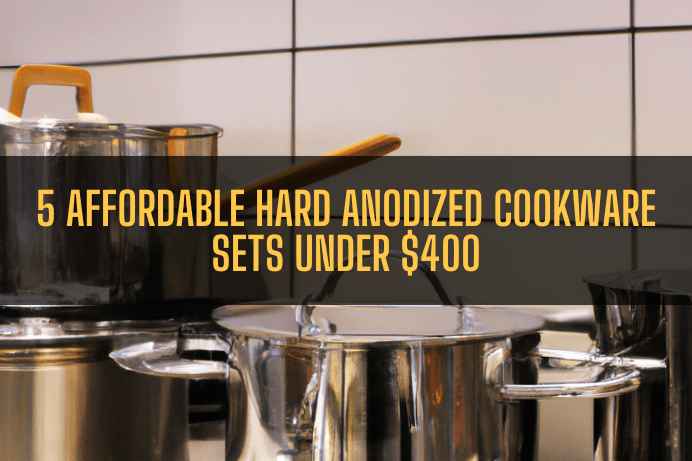Which is Better Nonstick or Stainless Steel – Full Guide 2024
When it comes to cookware, two of the most popular options are nonstick and stainless steel. Both have their ardent fans and detractors. Non-stick cookware is known for its slick, easy-to-clean surface, while stainless steel is prized for its durability and versatility. So which one is better?
In this comprehensive guide, we’ll examine the pros and cons of non-stick and stainless steel cookware. You’ll learn about the different materials used in each type of cookware, their health and safety considerations, ease of use and care, and performance for different types of cooking tasks. We’ll also provide tips on when you should choose one over the other.
By the end of this guide, you’ll have all the information you need to decide whether non-stick or stainless steel is right for your kitchen. You’ll gain insight into the key factors to weigh when shopping for new pots and pans. Let’s dive in and settle the non-stick vs. stainless steel debate once and for all!
Stainless Steel Vs Nonstick Which One Better?
When we Compare stainless steel & non-stick, there are tradeoffs to consider. Stainless steel is more durable over the long run, as quality pieces can last for decades. It’s also better for high-heat cooking methods like searing. However, stainless steel requires more oil or fat to prevent food from sticking. Non-stick cookware provides an ultra-slick cooking surface that makes cooking eggs, fish, and other delicate foods effortless. It’s easy to clean and often inexpensive to replace. But non-stick coatings eventually degrade over time and have health concerns related to overheating. Neither material is necessarily “better” overall.
The right choice comes down to your cooking style, priorities, and how much maintenance you’re willing to do. Evaluating your needs and kitchen habits will determine if stainless steel or non-stick is the winner for you.
What is Stainless Steel Cookware?
Stainless steel cookware refers to pots and pans made from stainless steel, which is steel alloyed with chromium and other metals like nickel, titanium, copper, and molybdenum. The chromium creates a protective oxidized layer on the steel that makes it resistant to corrosion and rust. Stainless steel is durable, sturdy cookware that conducts heat well and evenly. It’s also non-reactive, so it won’t react with acidic foods. Quality stainless steel cookware can last for many years with proper care.
While it can develop hot spots if not combined with more conductive metals, clad stainless steel cookware has a core aluminum or copper layer to improve heat distribution. Stainless steel is generally safe for most cooking tasks besides extended high heat searing, which can cause the protective layer to deteriorate over time.
How to Use Stainless Steel Cookware?

Stainless steel cookware is extremely versatile and can be used for many different cooking methods. When using stainless steel pans, it’s important to properly preheat them before cooking. Preheat over medium heat for a few minutes until the pan is hot. Adding a small amount of oil or butter will help create a non-stick surface once the pan is preheated. Stainless steel excels at searing and browning the meat at higher heat, so take advantage of its durability for getting a nice crust on steaks, chops, etc.
It can also be used for steaming, boiling, braising, and pan-frying. Acidic ingredients like tomatoes, wine, and vinegar won’t react with stainless steel as they would with some other cookware materials. Just be sure to deglaze the pan and clean thoroughly after cooking acidic foods to avoid discoloration. With proper preheating and fat for lubrication, stainless steel cookware allows excellent browning and searing while remaining versatile for everyday cooking tasks.
What is NonStick Cookware?
Non-stick cookware refers to pots and pans that have been coated with a non-stick surface, usually polytetrafluoroethylene (PTFE), to prevent food from sticking during cooking. The non-stick coating allows you to cook with little or no oil and makes cooking and cleaning much easier. Foods easily slide off the slick non-stick surface without leaving residue behind. This makes non-stick cookware ideal for cooking delicate foods like eggs, fish, and pancakes that would otherwise fall apart or stick.
The non-stick surface also allows you to get a nice browned exterior on meats and veggies without food adhering to the pan. While Teflon is probably the most well-known brand, there are other non-stick finishes like ceramic and anodized aluminum that serve a similar non-adhesive function. No matter the exact material, non-stick cookware uses special coatings to create a slick, food-releasing cooking surface.
How To Use Nonstick Cookware?

The most common question is how to use nonstick cookware. It’s important to use non-stick pans and skillets over low to medium heat settings. Non-stick coatings are not made to withstand high cooking temperatures, even when you first start cooking. Although you can use some ceramic-based non-stick cookware for quick searing, avoid extended high-heat cooking on non-stick surfaces.
A good rule of thumb is that if a small amount of butter starts burning or smoking in the pan, the heat is too high for non-stick. Keeping non-stick cookware over low or medium burner settings will help preserve the non-stick coating and prevent it from deteriorating. Non-stick pans work best for gentle cooking methods like sautéing, simmering, and pan-frying delicate foods.
Pros & Cons of Stainless Steel Cookware
Pros:
- Extremely durable
- Can last a lifetime with proper care
- Withstands high heat for searing and browning
- Does not react with acidic foods
- Often has aluminum or copper core for even heating
- Easy to clean
Cons:
- Can develop hot spots if bottom not fully clad
- Food can stick without enough oil/butter
- Discoloration can occur over time
- Heavier than other cookware types
- Can be more expensive upfront
Also, recommended to read the pros and cons of buying stainless steel cookware
Pros & Cons of Nonstick Cookware
Pros:
- Provides slippery non-stick surface
- Makes cooking and cleaning easy
- Allows use of less oil or butter
- Great for cooking delicate foods like eggs
- Inexpensive to purchase
- Widely available
Cons:
- Coating degrades over time
- Not durable or long-lasting
- Cannot withstand high heat
- Potential health concerns if overheated
- Not safe for use with metal utensils
- Handwash only recommended
- Can scratch and lose non-stick properties
Is Stainless Steel Safer Than Non-Stick
When it comes to safety, stainless steel cookware has a clear advantage over non-stick options. Stainless steel contains no toxic chemicals and does not react with food during cooking. High-quality stainless steel can provide a non-stick cooking surface when properly preheated and lubricated with oil or butter. In contrast, non-stick cookware relies on chemical coatings like PTFE or PFOA, which can degrade at high heat and potentially release harmful fumes. The non-stick coating itself also eventually wears off over time with normal use. For stable, non-toxic cookware that lasts for decades, stainless steel is widely regarded as the safest choice over non-stick.
Which is Better To Cook with Stainless Steel or Nonstick?
For high-heat cooking like searing or pan roasting, stainless steel is better. For delicate foods like eggs, fish, or pancakes that require less cooking time or oil, non-stick is preferable.
When You Should Buy New Stainless Steel & Nonstick Pots & Pans?

Stainless Steel:
- When pans warp or the bottom is uneven
- If the cooking surface develops hot spots or scorching
- When the exterior shows corrosion, rust, or pitting
- If handles loosen over time
Non-Stick:
- When the non-stick coating scratches, chips, or peels
- If foods start sticking when cooked
- If the surface seems slippery or glossy when it should be matte
- When pan bottoms become warped or uneven
In general, quality stainless steel lasts decades, while non-stick lasts a few years. Evaluate wear, cooking performance, and overall condition.
Want to buy Nonstick Cookware? Highly recommended 7 Best Nonstick Cookware To Use In 2023
FAQs
- When You Should Not Use Non-Stick?
Do not use non-stick cookware on high heat, under the broiler, or with a torch. Also, avoid non-stick if the coating is scratched or flaking. Metal utensils can damage the coating, so do not use them with non-stick cookware.
- When You Should Not Use Stainless Steel Cookware?
You should not use stainless steel cookware for extended high-heat cooking, allowing acidic foods to sit, baking, cooking delicate foods, or utilizing metal utensils that could scratch the surface.
- Can you Use Butter On Stainless Steel Cookware?
Yes, butter can be used to cook with stainless steel pans. The small amount of fat helps prevent sticking. Butter should be melted or clarified first so milk solids don’t burn. Avoid cooking butter alone on high heat.
- Do you need oil to cook on a stainless steel pan?
You can often fry certain dry, firm foods with low moisture like meats, mushrooms, and non-starchy vegetables in stainless steel cookware quite well without needing to add any oil. The steel browns and sears these ingredients nicely. More delicate, wet foods such as eggs, pancakes, and high-starch vegetables including potatoes still typically call for at least a small amount of fat or oil to be added to the stainless steel pan before cooking. This provides a light non-stick coating to prevent soft or wet foods from sticking to the steel.
- Can I cook vinegar in Stainless Steel?
Yes, vinegar can be cooked in stainless steel, but avoid extended exposure. The acidity can cause discoloration over time with prolonged contact. Add vinegar toward the end of cooking, rinse thoroughly after use, and don’t store or marinate foods in vinegar in stainless steel. With occasional use and proper care, cooking with some vinegar is fine.
- How to Cook With Stainless Steel Without Sticking?
Preheating stainless steel pans before adding oil or butter helps prevent sticking. Use medium heat, and allow the pan to fully heat up. Add just enough fat to coat the surface once hot. Stirring food frequently also prevents sticking. Acidic ingredients may need a bit more fat. Proper preheating creates a “non-stick” layer.
- What Pans are Best for Cooking Eggs Stainless Steel Or NonStick?
For cooking eggs, a non-stick pan is best to prevent sticking and create an evenly cooked surface. The slick coating allows eggs to slide out cleanly. Stainless steel can work if preheated properly with butter but requires more technique and fat to prevent adhesion.
Conclusion
When weighing stainless steel against nonstick cookware, both have advantages that make them useful additions to your kitchen arsenal. Stainless steel wins for its durability, versatility, and safety – it can last a lifetime and handles high-heat searing beautifully. Nonstick reigns supreme for cooking delicate foods that need a slippery surface like eggs, fish, and pancakes.
The ideal approach is to have both types of cookware readily available. Use non-stick for foods prone to sticking and low-oil cooking. Pull out stainless steel when you need to brown meat or vegetables over higher heat. Care for them properly, and they will serve you well for years to come.
Evaluate your own cooking style and priorities. For instance, if you love frying eggs every morning, a high-quality non-stick skillet may be non-negotiable. Or if you frequently cook acidic tomato sauces, stainless steel’s nonreactive surface makes it the clear choice. With the pros, cons and proper uses for each now well mapped out, you can find the best cookware setup for your needs.




